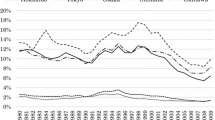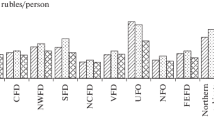Abstract
In many countries, the allocation of public funds among regions to promote the social capital formation in each regional unit is becoming one of the most important decisions by the central government. In spite of the significance of this problem, however, there is scarcely any definite guiding principle for the efficient regional allocation of public investment even in a theoretical sense. The causes of this may be explained as follows.
Access this chapter
Tax calculation will be finalised at checkout
Purchases are for personal use only
Preview
Unable to display preview. Download preview PDF.
Similar content being viewed by others
Notes
Rahman, Md. Anisur, “Regional Allocation of Investment,” Quarterly Journal of Economics, LXXVII, No. 1, February, 1963, pp. 26–39.
___, “Regional Allocation of Investment: The Continuous Version,” Quarterly Journal of Economics, LXXX, No. 1, February, 1966, pp. 159–160.
Our analysis, however, will be concentrated on the cases of two-region economy for the sake of simplicity. The results obtained in a two-region model can be generalized into those of three or more regions without essential difficulty.
Ilirschman, Albert O., The Strategy of Economic Development (New Haven: Yale University Press, 1958), chap. 5.
Musgrave, Richard A., The Theory of Public Finance: A Study in Public Economy (New York: McGraw-Hill, 1959), chap. 20, C.
As one of the recent contributions to the measurement of public investment benefits, see Dorfman, Robert, ed., Measuring Benefits of Government Investments (Washington, D. C.: The Brookings Institution, 1963).
Musgrave, op. cit., chap. 20, C, pp. 484–487.
Rahman, op. cit. Also see Sakashita, N., “Regional Allocation of Investment: A Further Comment,” mimeograph, April, 1965.
Refer to the previous Chapter for the complete system of notation.
See the Section, Disaggregation of σ i and λ, concerning the implications of σ i, si, and λ.
Pontryagin, L. S., and others, The Mathematical Theory of Optimal Processes, trans. by K. N. Trirogoff, (New York: John Wiley & Sons, Inc., 1962).
Ibid., pp. 68–69.
Ibid., p. 69.
Ibid., pp. 17–21, 66–9.
See the next Section of this Chapter for the economic interpretation of (37) and (38).
For a similar interpretation in a discrete time case, see Dorfman, Robert, “Regional Allocation of Investment: Comment,” Quarterly Journal of Economics, LXXVII, No. 1, February, 1963, pp. 162–165.
Pontryagin, op. cit., p. 16. Also see Bellman, R. E., Dynamic Programming (Princeton, New Jersey: Princeton University Press, 1957).
Sakashita, op. cit.
Author information
Authors and Affiliations
Editor information
Editors and Affiliations
Rights and permissions
Copyright information
© 1996 Springer-Verlag Berlin Heidelberg
About this chapter
Cite this chapter
Sakashita, N. (1996). Regional Allocation of Public Investment. In: Sasaki, K. (eds) Optimum and Equilibrium for Regional Economies. Springer, Berlin, Heidelberg. https://doi.org/10.1007/978-3-642-80135-8_1
Download citation
DOI: https://doi.org/10.1007/978-3-642-80135-8_1
Publisher Name: Springer, Berlin, Heidelberg
Print ISBN: 978-3-642-80137-2
Online ISBN: 978-3-642-80135-8
eBook Packages: Springer Book Archive




